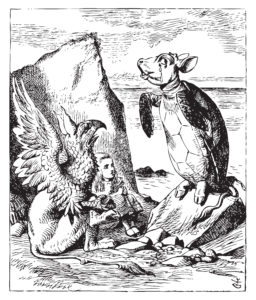You’ve just completed the project, and now you need to sit down and write the report. Staring at the blank computer screen, you wonder why it’s so hard to write short reports for clients. After all, they’re only a few pages. Here’s some help to get you started—or to overcome writer’s block.
What’s the question?
If a client is paying you to do something, it’s because they have a question to answer or a problem to solve. That question should be the focus of your report, so start and end with it. Your first paragraph will describe the question your client is asking and why it matters to them. That is, you need to frame the project from the reader’s point of view. Your conclusion will describe what you found, what it means, and what they should do next. Between the introduction and the conclusion, everything you write should somehow lead directly from the question to its answer. This will keep the report short and focused.
Organizing the information

“No, no! The adventures first,” said the Gryphon in an impatient tone: “explanations take such a dreadful time.”—Alice’s Adventures in Wonderland. Shutterstock image.
There are many different ways to organize a report. For short reports to clients, though, you basically have two choices for the overall flow. You can either report the findings immediately after the introduction or at the end. That is, you either lead with the results or take the chronological approach. Whichever way you do it, you won’t actually write up your findings until after you’ve thoroughly digested the information that leads to them. First you need to write about what you did, what results you got, and what they mean. Essentially, the outline closely follows the steps of the scientific method. The writing itself helps you process the information so that you can better understand what you have and what it means. Only then can you distill it into the findings. But whether you start or end with them, you need to sum up the main points for your client. And the findings should follow logically from your procedures, data, and observations. There should be no surprise endings.
Reporting data
Both long and short reports for clients usually contain a number of standard tests. You should already be familiar with the overall procedures of the tests you used, but it’s a good idea to review them every once in a while. You can briefly summarize the procedures for your client or just reference the standard by number, as “ASTM C39-21”. Be sure to include the date of the standard so the client knows which version you used. Standards specify what information must be in the report.
It’s good practice to make templates to help you keep track of all the information you need to provide. You can append your data sheets to the report. However, you should also summarize and discuss the results in your report. If you have just a few test results, you could put them in the text. However, the more data you have, the more cumbersome they will be for your client to sort through.
That’s where tables and figures come in. Your selection of which data to include in a table and which variables you plot together in graphs will highlight certain patterns or trends. It’s up to you to determine the significance of these patterns. The process of assembling tables or plotting graphs can be very helpful to you in understanding what your results mean. However, it’s important not to juxtapose unrelated data, as the juxtaposition itself implies a relationship. That is, the choice of what to include in a table or figure has ethical implications.
How much to explain?
How much detail you need to explain depends on your client. Someone who’s knowledgeable about the topic will want you to get to the point without bogging down in explanations. But someone who’s new to the topic—or who doesn’t have a scientific or engineering background—will get lost if you use a lot of unfamiliar technical terms. You need to know your client. Presumably you’ve been working with them for some time before your write your report, so you’ll have some idea of how much and what kind of explanations to provide. At a minimum, though, you need to provide enough “tracks” that someone unfamiliar with the project can follow what you did and replicate it if necessary.
As I’ve taught technical writing to engineering students, I’ve come to realize that writing reports for clients isn’t so much about the writing as it is about the relationship. The better you know your client, the better you can understand what they need so you can provide it in a form they can use.
